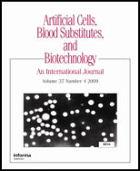|
Literature / Source Database:
Artificial Cells, Blood Substitutes, and Biotechnology
Description
an international journal
| Title (short) |
Art. Cells, Blood Subs., Biotech. |
| CODEN |
ABSBE4 |
| First year |
1994 |
| Impact factor |
0.688 |
|
|

|
Status
active
Indexing
Academic Search Complete, Biochemistry and Biophysics Citation Index, Biological Abstracts, Biomedical Reference Collection: Comprehensive, BIOSIS Full Coverage Shared, BIOSIS Previews, Biotechnology Abstracts, Biotechnology Citation Index, COMPENDEX, EMBASE, EMBIOLOGY, Journal Citation Reports/Science Edition, Materials Science Citation Index, PubMed/MedLine, Science Citation Index, SciSearch, SCOPUS, SIIC.
Predecessor
Biomaterials, artificial cells, and immobilization biotechnology
Subject

Source type
Journal
Publisher
ISBN ISSN
1073-1199
E ISSN
1532-4184
First volume
1
Last volume
38+
Publish city
London
Homepage
| Resources |
|
Availability |
|
|
|
|
|
| Text PDF |
 |
free access |
 |
| Text Html |
 |
for subscriber |
 |
| References |
 |
not available |
 |
| Abstracts |
 |
|
|
| TOC |
 |
|
|
|
|
|
|

Description
Artificial Cells, Blood Substitutes, and Biotechnology covers the frontiers of interdisciplinary research and application, combining artificial cells, nanotechnology, nanobiotechnology, biotechnology, molecular biology, bioencapsulation, novel carriers, stem cells and tissue engineering. Emphasis is on basic research, applied research, and clinical and industrial applications of the following topics: - artificial cells
- blood substitutes
- nanotechnology, nanobiotecnology, nanomedicine
- tissue engineering
- stem cells
- bioencapsulation
- microencapsulation and nanoencapsulation
- microparticles and nanoparticles
- liposomes
- cell therapy and gene therapy
- enzyme therapy
- drug delivery systems
- biodegradable and biocompatible polymers for scaffolds and carriers
- biosensors
- immobilized enzymes and their uses
- other biotechnological and nanobiotechnological approaches
Rapid progress in modern research cannot be carried out in isolation and is based on the combined use of the different novel approaches. The interdisciplinary research involving novel approaches, as discussed above, has revolutionized this field resulting in rapid developments. This journal serves to bring these different, modern and futuristic approaches together for the academic, clinical and industrial communities to allow for even greater developments of this highly interdisciplinary area.   
|